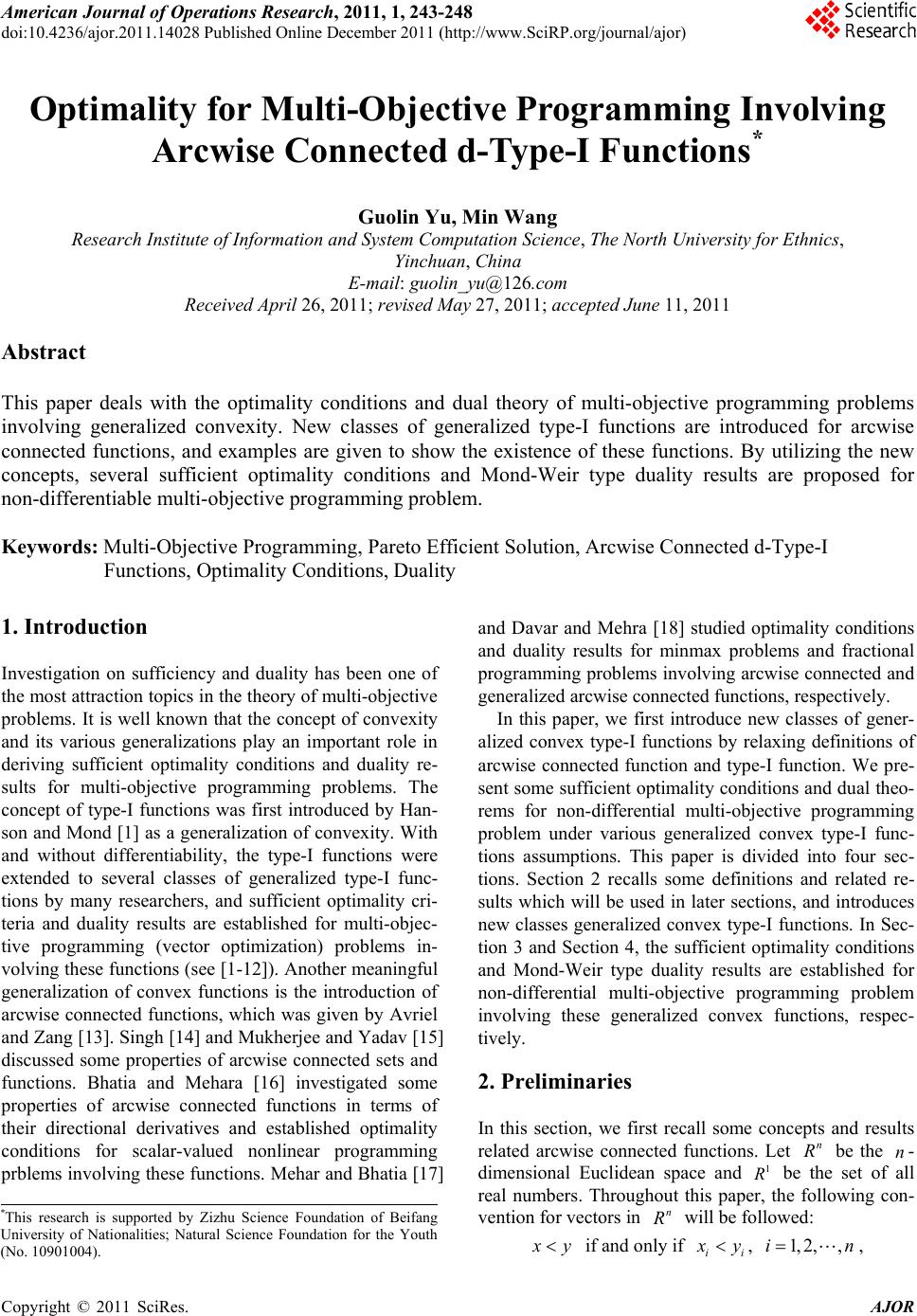 American Journal of Oper ations Research, 2011, 1, 243-248 doi:10.4236/ajor.2011.14028 Published Online December 2011 (http://www.SciRP.org/journal/ajor) Copyright © 2011 SciRes. AJOR 243 Optimality for Multi-Objective Programming Inv olvi ng Arcwise Connected d-Type-I Functions* Guolin Yu, Min Wang Research Institute of Information and System Computation Science, The North University fo r Ethn ics, Yinchuan, China E-mail: guolin_yu@126.com Received April 26, 2011; revised May 27, 2011; accepted June 11, 2011 Abstract This paper deals with the optimality conditions and dual theory of multi-objective programming problems involving generalized convexity. New classes of generalized type-I functions are introduced for arcwise connected functions, and examples are given to show the existence of these functions. By utilizing the new concepts, several sufficient optimality conditions and Mond-Weir type duality results are proposed for non-differentiable multi-objective programming problem. Keywords: Multi-Objective Programming, Pareto Efficient Solution, Arcwise Connected d-Type-I Functions, Optimality Conditions, Duality 1. Introduction Investigation on sufficiency and duality has been one of the most attraction topics in the theory of multi-objectiv e problems. It is well known that the concept of convexity and its various generalizations play an important role in deriving sufficient optimality conditions and duality re- sults for multi-objective programming problems. The concept of type-I functions was first introduced by Han- son and Mond [1] as a generalization of co nvexity. With and without differentiability, the type-I functions were extended to several classes of generalized type-I func- tions by many researchers, and sufficient optimality cri- teria and duality results are established for multi-objec- tive programming (vector optimization) problems in- volving these functions (see [1-12]). Another meaningful generalization of convex functions is the introduction of arcwise connected functions, which was given by Avriel and Zang [13]. Singh [14] and Mukherjee and Yadav [15] discussed some properties of arcwise connected sets and functions. Bhatia and Mehara [16] investigated some properties of arcwise connected functions in terms of their directional derivatives and established optimality conditions for scalar-valued nonlinear programming prblems involving these functions. Mehar and Bhatia [17] and Davar and Mehra [18] studied optimality conditions and duality results for minmax problems and fractional programming problems involving arcwise connected and generalized arcwise connected functions, respectively. In this paper, we first introduce new classes of gener- alized convex type-I functions by relaxing definitions of arcwise connected function and type-I function. We pre- sent some sufficient optimality cond itions and dual theo- rems for non-differential multi-objective programming problem under various generalized convex type-I func- tions assumptions. This paper is divided into four sec- tions. Section 2 recalls some definitions and related re- sults which will be used in later sections, and introduces new classes generalized convex type-I functions. In Sec- tion 3 and Section 4, the sufficient optimality conditions and Mond-Weir type duality results are established for non-differential multi-objective programming problem involving these generalized convex functions, respec- tively. 2. Preliminaries In this section, we first recall some concepts and results related arcwise connected functions. Let be the n- dimensional Euclidean space and be the set of all real numbers. Throughout this paper, the following con- vention for vectors in will be followed: n R 1 R n R *This research is supported by Zizhu Science Foundation of Beifang University of Nationalities; Natural Science Foundation for the Youth (No. 10901004). y if and only if ii y, , 1, 2,,in 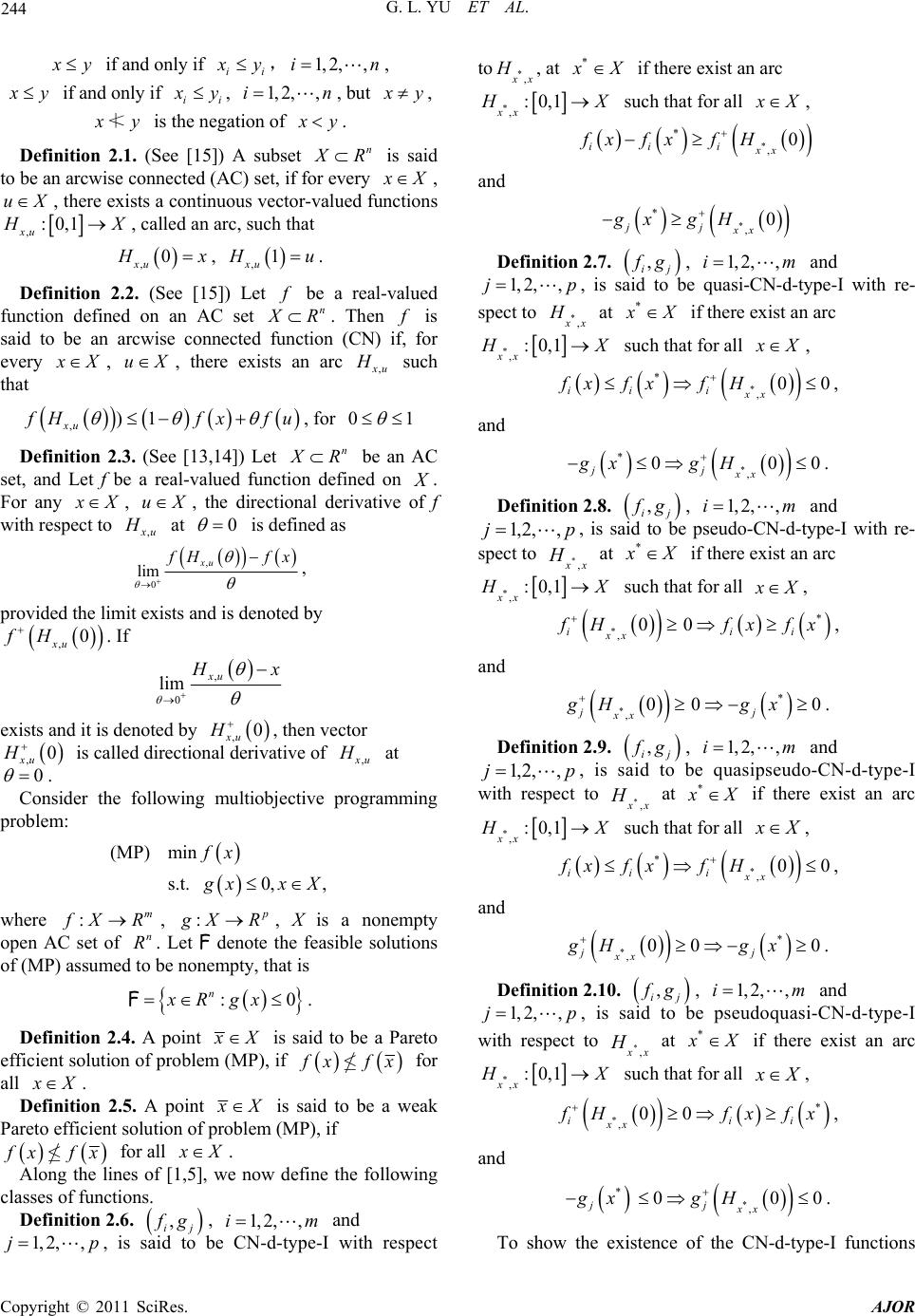 G. L. YU ET AL. 244 y if and only if ii y ,, 1, 2,,in y if and only if ii y1, , , but 2, ,in y , y≮ is the negation of y n . Definition 2.1. (See [15]) A subset R is said to be an arcwise connected (AC) set, if for every X , , there exists a continuous vector-valued functions uX ,xu :0,1 X ,xu , called an arc, such that 0 x, 1 ,xu u. Definition 2.2. (See [15]) Let be a real-valued function defined on an AC set n R. Then is said to be an arcwise connected function (CN) if, for every X, , there exists an arc uX, u such that )1 ,xu Hfxfu , for 01 Definition 2.3. (See [13,14]) Let n R be an AC set, and Let f be a real-valued function defined on . For any X X , , , the directional derivative of f with respect to uX u at 0 is defined as , 0 mli xu Hf x , provided the limit exists and is denoted by . If ,0 xu fH ,xu 0 mli x ,0 xu H exists and it is denoted by , then vector is called directional derivative of 0 ,xu H, u at 0 . Consider the following multiobjective programming problem: 0, fx(MP) min s.t. , xxX where :m XR , :p XR, X is a nonempty open AC set of . Let F denote the feasible solutions of (MP) assumed to be nonempty, that is n R ngx :0xRF. Definition 2.4. A point X is said to be a Pareto efficient solution of problem (MP), if xfx for all X. Definition 2.5. A point X is said to be a weak Pareto efficient solution of problem (MP), if xfx for all X. Along the lines of [1,5], we now define the following classes of functions. Definition 2. 6. , ij g, 1, 2,, im and 1,2, ,jp, is said to be CN-d-type-I with respect to *, x H, at * X if there exist an arc *,:0,1 xx X such that for all X, * * ,0 ii i xx fxfxf H and * * ,0 jj xx gx gH Definition 2. 7. , ij g, and 1,2, ,im 1, 2,,jp , is said to be quasi-CN-d-type-I with re- spect to *, x H at * X if there exist an arc *,:0,1 xx X such that for all X, * * ,00 ii i xx fxfxfH , and * * , 00 jj xx gx gH 0 . Definition 2. 8. , ij g, and 1,2, ,im pj ,,2,1 , is said to be pseudo-CN-d-type-I with re- spect to at if there exist an arc xx H, *Xx * *,:0,1 xx X such that for all , Xx ** ,00 ii xx i Hfx fx , and ** ,00 jj xx gH gx 0. Definition 2. 9. ,fg ij , and 1, 2,,im pj ,,2,1 , is said to be quasipseudo-CN-d-type-I with respect to at if there exist an arc xx H, *Xx * *,:0,1 xx X such that for all , Xx * * ,00 ii i xx fxfxfH , and ** ,00 jj xx gH gx 0. Definition 2.10. ,fg ij , and 1, 2,,im 1, 2,,jp , is said to be pseudoquasi-CN-d-type-I with respect to at xx H, * * X if there exist an arc *,:0,1 xx X such that for all , Xx ** ,00 ii xx fHfx fx i , and * * , 00 jj xx gx gH 0 . To show the existence of the CN-d-type-I functions Copyright © 2011 SciRes. AJOR 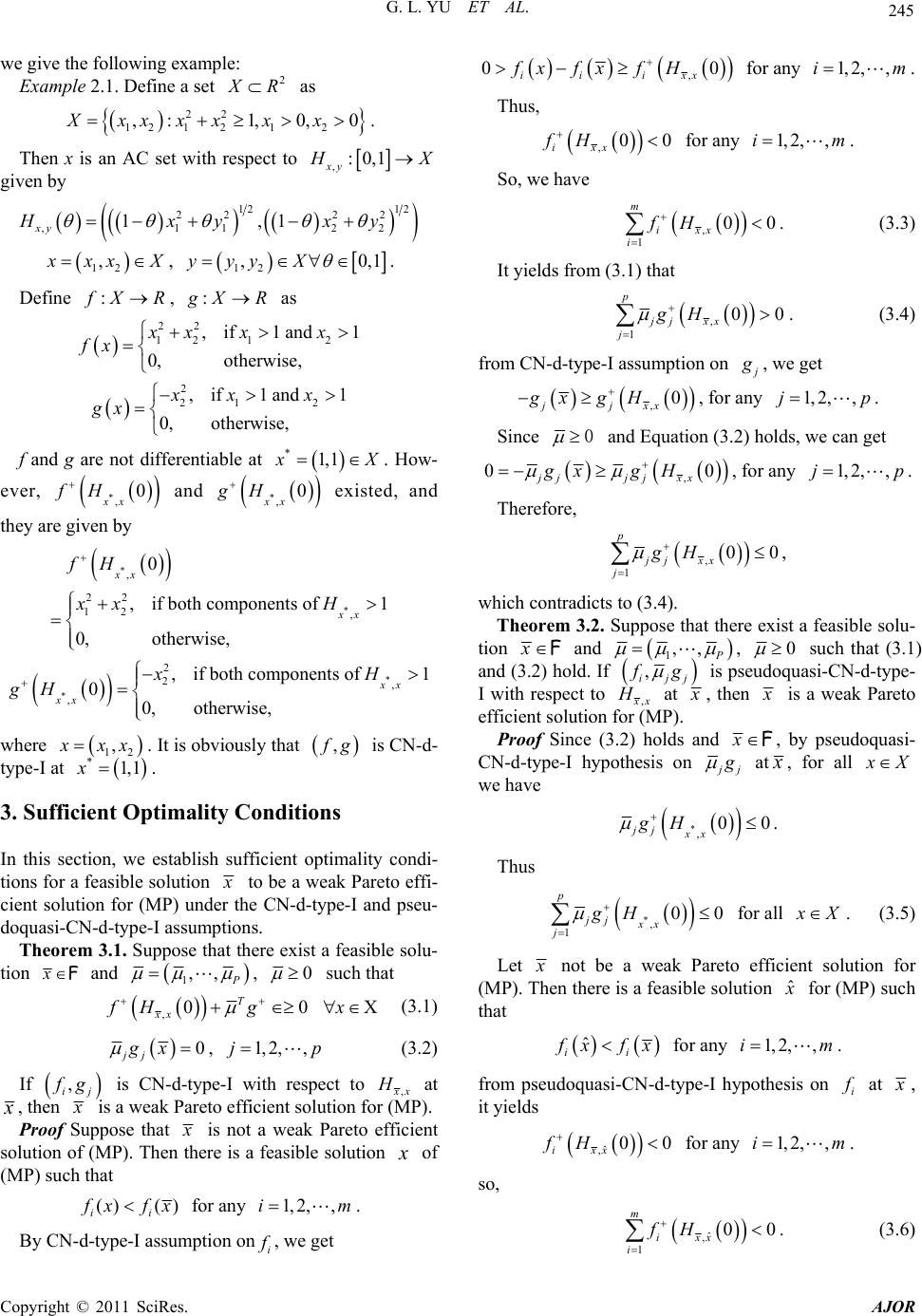 245 G. L. YU ET AL. we give the following exam ple: Example 2.1. Define a set 2 R as 22 12 1212 ,:1, 0,0Xxxxxx x . Then x is an AC set with respect to ,:0,1 xy X given by 12 12 22 22 ,112 1,1 xy Hxyx 2 y 12 , xx X, 12 ,0yyy X ,1. Define , :fX R: XR as 22 12 12 ,if 1 and 1 0, otherwise, xx xx fx 2 21 2 ,if 1 and 1 0, otherwise, xx x gx * f and g are not differentiable at 1,1 X . How- ever, and *,0 xx fH *,0 xx gH existed, and they are given by * * , 22 12 , 0 ,if both components of 1 0, otherwise, xx xx fH xx H * * 2 2, , ,if both components of 00, otherwise, xx xx x gH H 1 where 12 , xx. It is obviously that , g is CN-d- type-I at . *1,1x 3. Sufficient Optimality Conditions In this section, we establish sufficient optimality condi- tions for a feasible solution to be a weak Pareto effi- cient solution for (MP) under the CN-d-type-I and pseu- doquasi-CN-d-type- I assumptions. Theorem 3.1. Suppose that there exist a feasible solu- tion xF and 1,, , 0 such that ,00 T xx fHg x X (3.1) 0 jj gx , 1, 2,,jp (3.2) If , ij g is CN-d-type-I with respect to , x at , then is a weak Pareto efficient solution for (MP). Proof Suppose that is not a weak Pareto efficient solution of (MP). Then th ere is a feasible solution of (MP) such that () () ii xfx for any . 1, 2,,im By CN-d-type-I assumption on, we get i f , 00 ii ixx fxfxf H for any . 1, 2,, im Thus, ,0 ixx fH 0 for any . 1,2,,im So, we have , 1 0 m ixx i fH 0. (3.3) It yields from (3.1) that , 10 p jj xx j gH 0. (3.4) from CN-d-type-I assumption on , we get ,0 jjxx gx gH , for any . 1, 2,,jp Since 0 and Equation (3.2) holds, we can get , 00 jjjj xx gx gH , for any . 1, 2,,jp Therefore, , 100 p jj xx j gH , which contradicts to (3.4). Theorem 3.2. Suppose that there exist a feasible solu- tion x F and 1,, , 0 such that (3.1) and (3.2) hold. If , ijj g is pseudoquasi-CN-d-type- I with respect to , x at , then is a weak Pareto efficient solution for (MP). Proof Since (3.2) holds and xF, by pseudoquasi- CN-d-type-I hypothesis on j at , for all X we have *,00 jj xx gH . Thus *, 10 p jj xx j gH X. (3.5) 0 for all Let not be a weak Pareto efficient solution for (MP). Then there is a feasible solution ˆ for (MP) such that ˆ ii xfx for any . 1, 2,,im from pseudoquasi-CN-d-type-I hypothesis on i at , it yields ˆ ,0 ixx fH 0 for any . 1,2,,im so, ˆ , 1 0 m ixx i fH 0. (3.6) Copyright © 2011 SciRes. AJOR 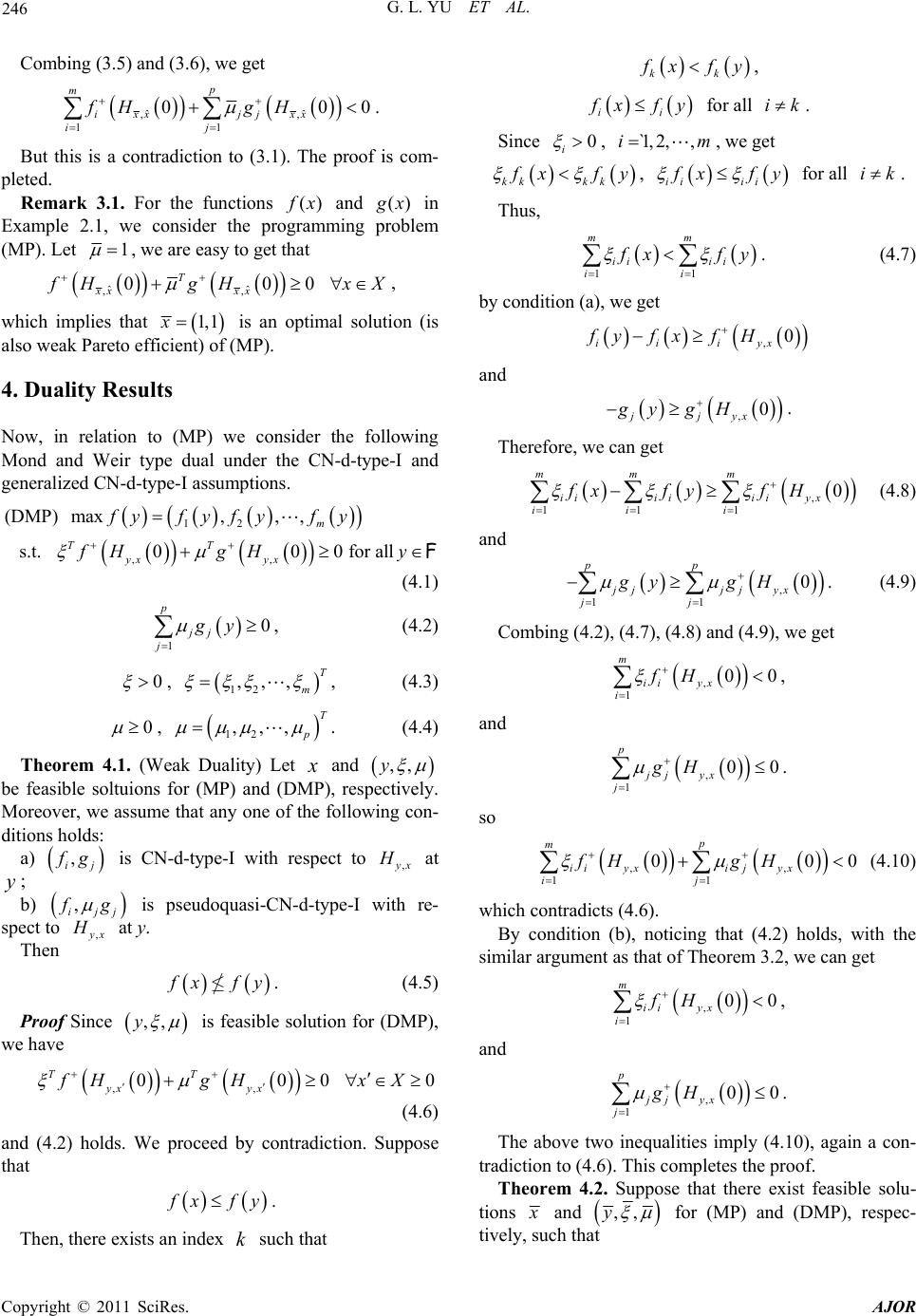 G. L. YU ET AL. 246 Combing (3.5) and (3.6), we get ˆˆ ,, 11 00 p m ixx jjxx ij fH gH 0. But this is a contradiction to (3.1). The proof is com- pleted. Remark 3.1. For the functions () x and () x in Example 2.1, we consider the programming problem (MP). Let 1 , we are easy to get that ˆˆ ,, 000 T xx xx HgH x X , which implies that 1,1x is an optimal solution (is also weak Pareto efficient) of (MP). 4. Duality Results Now, in relation to (MP) we consider the following Mond and Weir type dual under the CN-d-type-I and generalized CN-d-type-I assumptions. 12 ,, (DMP) max,,, s.t. 000 for all m TT yx yx fyfy f yfy fH gHy F (4.1) 10 p jj j gy , (4.2) 0 , , (4.3) 12 ,,, T m 0 , . (4.4) 12 ,,, T p Theorem 4.1. (Weak Duality) Let and ,,y be feasible soltuions for (MP) and (DMP), respectively. Moreover, we assume that any one of the following con- ditions holds: a) , ij g is CN-d-type-I with respect to , x at ; yb) , ijj g , is pseudoquasi-CN-d-type-I with re- spect to x at y. Then xfy. (4.5) Proof Since ,,y is feasible solution for (DMP), we have ,, 000 TT yx yx fH gHxX 0 (4.6) and (4.2) holds. We proceed by contradiction. Suppose that xfy. Then, there exists an index such that k kk xfy, ii xfy for all i. k Since 0 i , `1,2 ,,im , we get kk kk xf y, ii ii xf y for all ik . Thus, 11 mm ii ii ii xf y. (4.7) by condition (a), we get ,0 iiiyx fyfxf H and ,0 jjyx gy gH 0 . Therefore, we can get , 11 10 mm m iiiiiiyx ii i fxfyf H (4.8) and , 11 0 pp jjjjyx jj gy gH . (4.9) Combing (4.2), (4.7) , (4.8) and (4.9 ), we get , 100 m ii yx i fH , and , 100 p jj yx j gH . so ,, 11 00 p m i iyxijyx ij fH gH (4.10) which contradicts (4.6). By condition (b), noticing that (4.2) holds, with the similar argument as that of Theorem 3.2, we can get , 1 00 m ii yx i fH , and , 100 p jj yx j gH . The above two inequalities imply (4.10), again a con- tradiction to (4.6). This completes the proof. Theorem 4.2. Suppose that there exist feasible solu- tions and ,,y for (MP) and (DMP), respec- tively, such that Copyright © 2011 SciRes. AJOR 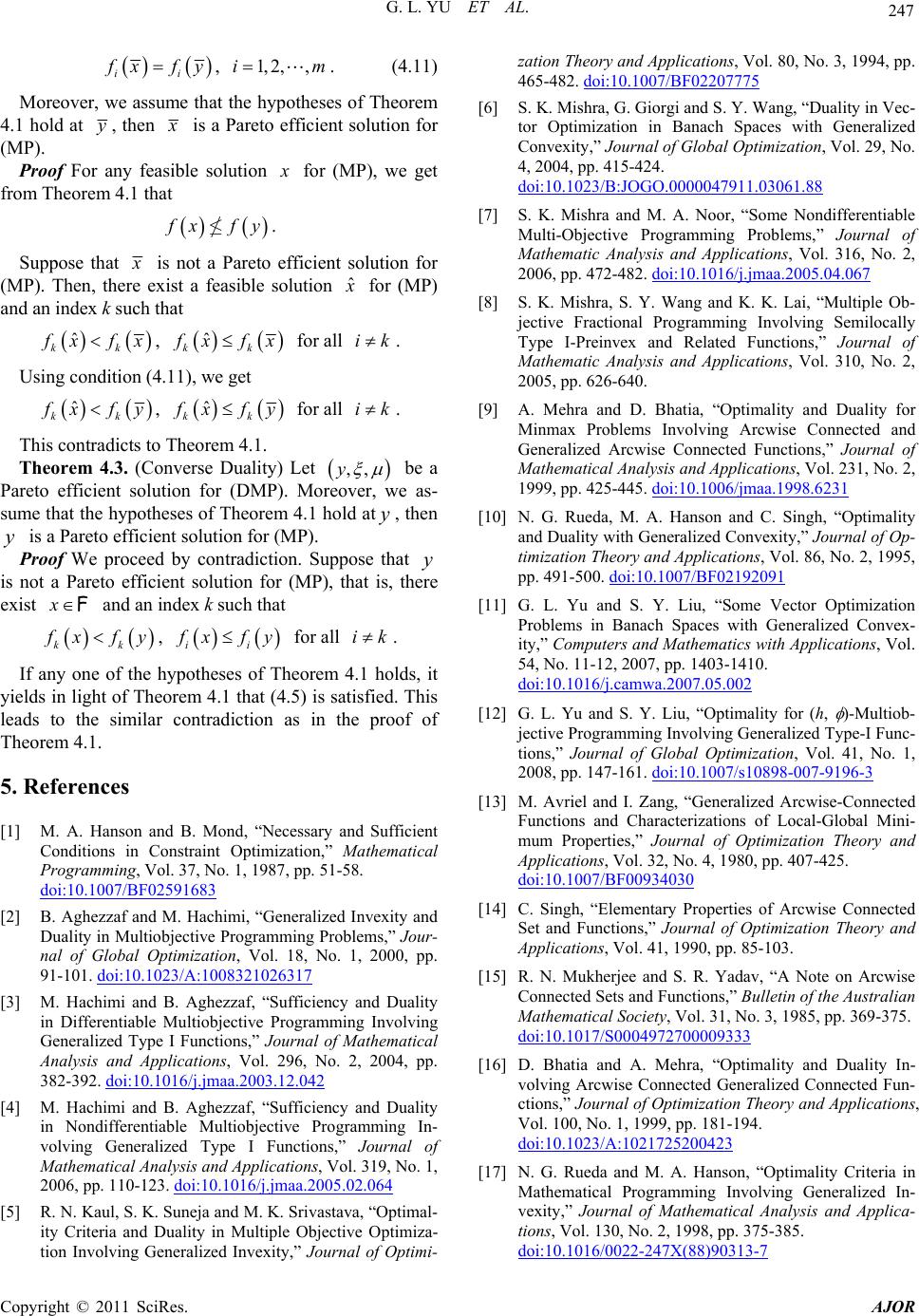 247 G. L. YU ET AL. ii xfy, . (4.11) 1, 2,,im Moreover, we assume that the hypotheses of Theorem 4.1 hold at , then is a Pareto efficient solution for (MP). Proof For any feasible solution for (MP), we get from Theorem 4.1 that xfy. Suppose that is not a Pareto efficient solution for (MP). Then, there exist a feasible solution ˆ for (MP) and an index k such that ˆ kk xfx, ˆ kk xfx for all ik . Using condition (4.11), we get ˆ kk xfy, ˆ kk xfy for all ik . This contradicts to Theorem 4.1. Theorem 4.3. (Converse Duality) Let ,,y y be a Pareto efficient solution for (DMP). Moreover, we as- sume that the hypotheses of Theorem 4.1 hold at, then is a Pareto efficient solution for (MP). yProof We proceed by contradiction. Suppose that is not a Pareto efficient solution for (MP), that is, there exist and an index k such that y xF kk xfy, ii xfy for all ik . If any one of the hypotheses of Theorem 4.1 holds, it yields in light of Theorem 4.1 that (4.5) is satisfied. This leads to the similar contradiction as in the proof of Theorem 4.1. 5. References [1] M. A. Hanson and B. Mond, “Necessary and Sufficient Conditions in Constraint Optimization,” Mathematical Programming, Vol. 37, No. 1, 1987, pp. 51-58. doi:10.1007/BF02591683 [2] B. Aghezzaf and M. Hachimi, “Generalized Invexity and Duality in Multiobjective Programming Problems,” Jour- nal of Global Optimization, Vol. 18, No. 1, 2000, pp. 91-101. doi:10.1023/A:1008321026317 [3] M. Hachimi and B. Aghezzaf, “Sufficiency and Duality in Differentiable Multiobjective Programming Involving Generalized Type I Functions,” Journal of Mathematical Analysis and Applications, Vol. 296, No. 2, 2004, pp. 382-392. doi:10.1016/j.jmaa.2003.12.042 [4] M. Hachimi and B. Aghezzaf, “Sufficiency and Duality in Nondifferentiable Multiobjective Programming In- volving Generalized Type I Functions,” Journal of Mathematical Analysis and Applications, Vol. 319, No. 1, 2006, pp. 110-123. doi:10.1016/j.jmaa.2005.02.064 [5] R. N. Kaul, S. K. Suneja and M. K. Srivastava, “Optimal- ity Criteria and Duality in Multiple Objective Optimiza- tion Involving Generalized Invexity,” Journal of Optimi- zation Theory and Applications, Vol. 80, No. 3, 1994, pp. 465-482. doi:10.1007/BF02207775 [6] S. K. Mishra, G. Giorgi and S. Y. Wang, “Duality in Vec- tor Optimization in Banach Spaces with Generalized Convexity,” Journal of Global Optimization, Vol. 29, No. 4, 2004, pp. 415-424. doi:10.1023/B:JOGO.0000047911.03061.88 [7] S. K. Mishra and M. A. Noor, “Some Nondifferentiable Multi-Objective Programming Problems,” Journal of Mathematic Analysis and Applications, Vol. 316, No. 2, 2006, pp. 472-482. doi:10.1016/j.jmaa.2005.04.067 [8] S. K. Mishra, S. Y. Wang and K. K. Lai, “Multiple Ob- jective Fractional Programming Involving Semilocally Type I-Preinvex and Related Functions,” Journal of Mathematic Analysis and Applications, Vol. 310, No. 2, 2005, pp. 626-640. [9] A. Mehra and D. Bhatia, “Optimality and Duality for Minmax Problems Involving Arcwise Connected and Generalized Arcwise Connected Functions,” Journal of Mathematical Analysis and Applications, Vol. 231, No. 2, 1999, pp. 425-445. doi:10.1006/jmaa.1998.6231 [10] N. G. Rueda, M. A. Hanson and C. Singh, “Optimality and Duality with Generalized Convexity,” Journal of Op- timization Theory and Applications, Vol. 86, No. 2, 1995, pp. 491-500. doi:10.1007/BF02192091 [11] G. L. Yu and S. Y. Liu, “Some Vector Optimization Problems in Banach Spaces with Generalized Convex- ity,” Computers and Mathematics with Applications, Vol. 54, No. 11-12, 2007, pp. 1403-1410. doi:10.1016/j.camwa.2007.05.002 [12] G. L. Yu and S. Y. Liu, “Optimality for (h, )-Multiob- jective Programming Involving Generalized Type-I Func- tions,” Journal of Global Optimization, Vol. 41, No. 1, 2008, pp. 147-161. doi:10.1007/s10898-007-9196-3 [13] M. Avriel and I. Zang, “Generalized Arcwise-Connected Functions and Characterizations of Local-Global Mini- mum Properties,” Journal of Optimization Theory and Applications, Vol. 32, No. 4, 1980, pp. 407-425. doi:10.1007/BF00934030 [14] C. Singh, “Elementary Properties of Arcwise Connected Set and Functions,” Journal of Optimization Theory and Applications, Vol. 41, 1990, pp. 85-103. [15] R. N. Mukherjee and S. R. Yadav, “A Note on Arcwise Connected Sets and Functions,” Bulletin of the Australian Mathematical Society, Vol. 31, No. 3, 1985, pp. 369-375. doi:10.1017/S0004972700009333 [16] D. Bhatia and A. Mehra, “Optimality and Duality In- volving Arcwise Connected Generalized Connected Fun- ctions,” Journal of Optimization Theory and Applications, Vol. 100, No. 1, 1999, pp. 181-194. doi:10.1023/A:1021725200423 [17] N. G. Rueda and M. A. Hanson, “Optimality Criteria in Mathematical Programming Involving Generalized In- vexity,” Journal of Mathematical Analysis and Applica- tions, Vol. 130, No. 2, 1998, pp. 375-385. doi:10.1016/0022-247X(88)90313-7 Copyright © 2011 SciRes. AJOR  G. L. YU ET AL. Copyright © 2011 SciRes. AJOR 248 [18] S. Davar and A. Mehra, “Optimality and Duality for Fractional Programming Problems Involving Arcwise Connected Functions and Their Applications,” Journal of Mathematical Analysis and Applications, Vol. 263, No. 2, 2001, pp. 666-682. doi:10.1006/jmaa.2001.7651
|